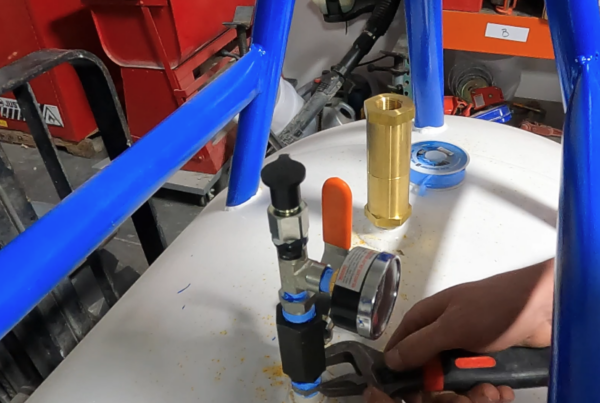Foam Dispensing Equipment daily Quality Control procedures
At FSI, quality is our top priority. That’s why we created this demonstration of the FSI chemical system quality control, or QC procedures. QC should be performed daily before production, and is imperative, in verifying that the equipment is dispensing good foam. FSI provides quick reference guides, and daily QC logs to make procedures and documentation easy. The daily QC steps include three basic checks: ratio, throughput and reactivity. Before beginning, make sure you have the following, protective eye wear and gloves, plastic bags to hold chemical of timed shots, scale and box for weighing chemical bags, calculator for computing ratios, stopwatch for timing reactivity, thin sturdy wire for checking reactivity, and a small box or trash can which is helpful for holding dispensed chemical.
Chemical Ratio quality check for foam dispensing equipment
The first check is the chemical ratio.
Having the proper ratio is critical in dispensing good foam and making a quality end product. Ratio is the weight comparison of the ISO (A) output to the POLYOL (B) output as an example, if the ISO weight is 1,319 grams, and the POLYOL weight is 950 grams, the ratio is 100:72, which is ideal for a PU system with a POLYOL target ratio range of 70-74. If the ratio dropped below 70, the in-foam would be ISO rich. If the ratio rose to over 74, the foam would be POLYOL rich.
If the ratio is not correct, improper foam qualities will result. ISO rich foam can be crunchy, have glassy cells, and result in less yield. POLYOL rich foam can be soft and spongy, can shrink, and can also result in less yield. Ratios are system specific and provided upon initial setup. If you’re not sure of the proper ratio for your system, please contact FSI technical service for assistance.
Let’s review the ratio procedures, start by making sure the mix tube adapter is attached to the SLUG block.
Now set the timer for the appropriate shot time, based on the gun output, which is measured in pounds per minute, or ppm. In this case we are using a 30 ppm gun, so we set the timer for 10 seconds. Open all ball valves and dispense a 3 second shot into a plastic bag to clear the lines.
Next, close the POLYOL ball valves and dispense a 10 second shot of ISO into a bag. Tie off the bag and place it so that the chemical does not run out. Reopen the POLYOL ball valves and dispense another shot into the bag, used prior, to clear the lines and prevent crossover.
Now close the ISO ball valves and dispense a 10 second shot of POLYOL into a new bag. Again, tie off the bag and secure it so that the chemical does not run out. Reopen the ISO ball valves and dispense a third short shot to clear the lines and prevent crossover. Air purge the gun for a minimum of 30 seconds.
Now you’re ready to weigh the chemical and calculate the ratio. Remember you only want to record the weight of the chemical itself, not the plastic bag, so you will need to tare or zero out the scale with an empty plastic bag. Remove the empty bag and place the bag of ISO chemical on the scale, and record the weight in the daily log. Remove the ISO bag and replace it with the POLYOL chemical bag, and record the weight. Now divide the POLYOL by the ISO to calculate the ratio.
In this example, the ISO weighed 1,355 grams and the POLYOL weighed 984 grams. Using the ratio Formula divide 984 by 1,355, then multiply by 100. Which results in a ratio of 72.6. Record this value in the B ratio column of the daily log. In this example, the ratio is within the target range of 70-74. If the ratio is in the desired range, you can move on to the throughput procedures. If the ratio is not in the desired range, call the FSI technical service department, adjustments may be necessary.
Now it is important to properly dispose of the two bags of chemicals used for calculating the ratio. Simply dump the contents of one bag into the other, and mix the two chemicals thoroughly. The foam can now be allowed to cure and then be safely discarded. Do not place the foam at a dumpster or trash can, until the bag has had 24 hours to cool down.
Throughput quality check for foam dispensing equipment
Now we are ready to check throughput. We define throughput, as the weight of the foam dispensed from the unit per minute. Commonly referred to as pounds per minute or ppm. To verify throughput, first attach the mix tube, open all four ball valves and dispense a 10 second shot into a plastic bag. Wait about five minutes until the foam is done rising, then weigh the foam on a gram scale. In this example, the foam weighs 2,280 grams. Since we want 8 pounds per minute value, multiply the weight of the 10 second shot by 6 to obtain a 60-second, or one minute, equivalent. In this example, we calculated a value of 13,680. Next, divide that value by 454, to convert the grams per minute into pounds per minute. In this example, the throughput of our 30 ppm gun is 30.13 ppm. The ppm is acceptable if it falls within five percent of the target throughput configured at initial setup.
Reactivity quality check for foam dispensing equipment
The final QC check is reactivity. There are two reactivity times to measure and report, string gel, and tack free times. Only one bag shot is needed to obtain both times. It is easiest to take this bag shot in a large box receptacle or trash can. It is important that the foam is not subjected to a cold surface which will cause a heat sink and will provide misleading reactivity times. Begin by simultaneously starting a stopwatch and triggering the slug unit, for a ten second shot. Allow the foam to rise. When the time elapsed is about ten seconds prior to the target gel time. Begin poking the rising foam four to twelve inches deep with a sturdy wire. After the initial poke, repeat five-second intervals in a fresh area of the foam surface until the foam sticks to the wire and becomes stringy, like the consistency of bubblegum. Record the elapsed time once stringy. Allow the stopwatch to continue to run to measure the tack free time. As a rule of thumb, tack free times are usually about double. The string gel is around this time. Start tapping the top of the foam gently with a tongue depressor, or your fingertip until the foam no longer sticks. At this point, record the elapsed time.
Now make sure both the string gel and tack free times are within ten percent of your target times. Once the ratio throughput and reactivity QC steps have been taken and verified, daily production can begin. Performing the daily quality control procedures will help assure you maintain high quality foam, resulting in high quality products. Appropriate shot times for different parts are typically determined in the initial setup, with the assistance of an FSI technical service representative. It is a good idea to keep a reference guide of product or part names, and corresponding shot times near the foaming station. If you have any questions about these procedures, please call our technical service department, at 1.800.325.4875. For international customers call, + 1 314.344.3330. We are always ready to help our valued customers in any way we can.




